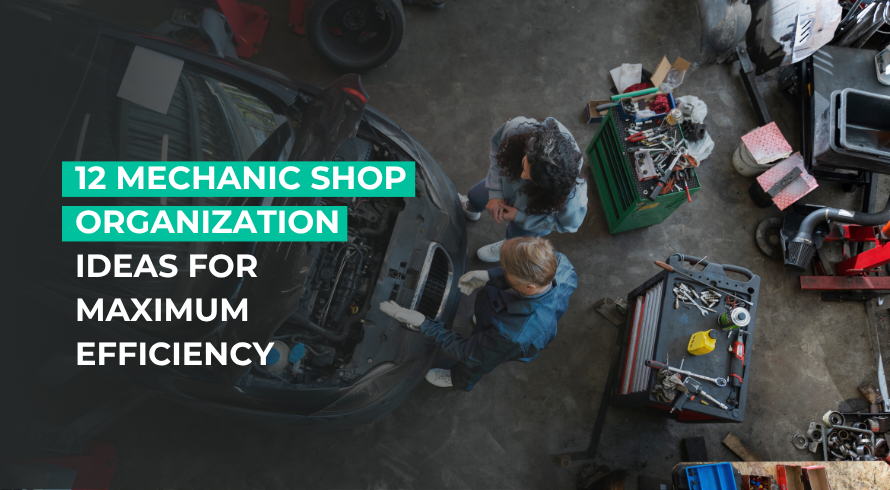If your auto repair shop has frequent tools missing, technicians are frustrated, and jobs are always getting late, then you might need to consider some serious organization for your shop. A properly organized shop can drive performance, and a poorly organized one will wreak havoc on performance.
We’re here to go over 12 actionable ways you can organize your shop for peak efficiency. Before that, let’s understand what real-world efficiency even looks like in a shop setting, so you can identify which areas of your shop need immediate attention.
Schedule a free demo today!

Boost your shop sales

Simplify shop management

Empower your technicians
What “peak efficiency” looks like in a well-organized shop
Every single minute your auto technicians spend looking for a wrench, or dodging a cluttered floor, or worse, tripping over the mess, you lose time and money. Your customers might not see what’s going on behind closed doors, but they might feel the impact. For instance, if their vehicle is dirty when it comes back, repair times are dragged, or even if services are rushed.
So, before your auto shop runs into this problem, let’s see which areas are falling short. Here’s what you need to look into:
Time management
See if your auto technicians are spending too much time finding the right tools. Do they spend more time looking for things to work with or getting the work done? This is a clear indicator of a poor layout and missing inventory.
Space optimization
Is your space optimized for efficiency, or is equipment all crammed together? Are there boxes upon boxes with random stuff that no one can find what’s needed? Wasted space slows everything down, and if it’s poorly organized, it might even create safety hazards.
Task coordination
How well are your technicians able to coordinate jobs? Do they spend more time waiting for parts or approvals? Do they meet their deadlines, or do jobs get stacked up simply because technicians spend time looking for the right parts to work with?
Accessibility of parts and tools
Are the frequently used tools easy to locate? Are they reachable? Or are they all buried under junk? Short delays can compound to hours of lost productivity.
Customer flow
If the cars outside are piling up and customers don’t know where to go, this is another indicator that the shop is badly organized. It will lead to a bad first impression and a disorganized service flow.
To counter the above areas, let’s talk about the ways to organize your shop to achieve peak efficiency. These are practical, easy to put into action, and can help you manage day-to-day challenges.
12 ways to organize your shop for peak efficiency
1. Use mobile tool carts for active jobs
If your auto shop has a stationary toolbox, techs lose time walking back and forth for frequently used tools. You can get mobile tool carts for different bays and active jobs. This makes it easier for auto technicians to drag the tool cart wherever they are going. This can store sockets, torque wrenches, and scanners close by.
For example, if a technician is working on brakes, they won’t need to cross the shop multiple times just to get the right tools. Less back and forth means the job gets done faster.
2. Color-code and label everything
Clearly label everything in the auto shop. Whether that is oil filters or electrical tools, put labels on all equipment. This will make it easy for anyone looking for specific things in the shop. You can also use color-coded buckets or bins for parts, fluids, and even specialty tools.
For instance, if you have a separate labeled bin for each vehicle brand (Toyota, Ford, etc), your auto technicians won’t waste time hunting for the right parts as they are servicing.
3. Implement a digital job board
When you have one or two bays, a whiteboard is sufficient to manage jobs. However, as your auto shop scales, invest in a shop management system with a digital job board. These will give you a better understanding of tech assignments, time tracking, and it will help you manage queue visibility. You can get tablets in the bay. This will help all your technicians stay in sync.
4. Assign dedicated zones for each task type
Divide your shop space into zones. You can make separate zones for diagnostics, tire/wheel, quick oil changes, and complex repairs. This depends on what type of jobs you get the most. This helps manage the flow and reduces cross-traffic. This way, someone working on transmission fluids won’t be interrupted by tire rotations. They will have their zones and allocated spaces.
5. Audit and purge unused equipment monthly
Often auto shops still have outdated equipment lying around. These take up a lot of space. This space can be better allocated to other newer equipment. It’s always a good practice to perform a monthly or quarterly audit. Remove any unused equipment that hasn’t been used in over 60 days.
Use an auto parts inventory management system to save time and track all inventory and equipment in your shop.
6. Store frequently used parts near bays
The most commonly used parts, such as brake pads, oil filters, bulbs, etc, should all be placed near workstations. They need to be easily accessible. In case they are stored across the shop, it’s time to reallocate them near the required area.
Even if you reduce time per repair by 5-7 minutes, it can help your auto technicians take on dozens of more jobs per week.
7. Set up a centralized diagnostic station
At times, diagnostic tools are scattered around or in a tech’s toolbox. Instead, you can create a shared diagnostic bay. Keep it stocked with scan tools, multimeters, service manuals, etc. This reduces tool hoarding, and all technicians will know where all the critical tools are.
8. Build a designated receiving area for parts deliveries
How often do you get parts delivered to the auto shop? Do they arrive randomly at the front counter? This will create chaos and reduce productivity. Assign a delivery zone. Add intake shelving and barcode scanners. This will help you manage parts delivery better. You will avoid delays with misplaced deliveries or mixing parts for different jobs.
9. Create Standard Operating Procedures (SOPs)
More than just labeling shelves, organized shops have set proper standard operating procedures in place. They have systems. These standardize work and remove any confusion. Common tasks such as oil changes, tire rotations, parts returns, etc, can all follow proper SOPs. Make a list of your SOPs and place them in each bay. Otherwise, keep them on tablets. Every staff member must be aware of these SOPs.
10. Schedule daily cleanup time
At closing, don’t leave the shop in chaos. Keep the last 30 minutes of the day to clean and reset the area. The next morning, they will come back to a clean space, which will boost productivity the next day. They start each day fresh, without having to fix the last day’s mess.
11. Use vertical storage to free floor space
Pegboards, wall-mounted racks, plus ceiling hooks are great for storing ladders, hoses, and extension cords. When everything is up against the wall, it frees up walkways. A free floor space also reduces trip hazards and makes it safe for technicians to walk across during busy hours.
12. Track tool usage with a checkout system
When tools go missing, it wastes the tech’s time. Either use a clipboard or a digital tracker to know which tech is using which specialty tool. Even add in how long they will have it, so everyone knows how long before they can get that particular tool. This will reduce ‘where’s the scanner’ arguments on the shop floor.
Wrapping up
Organizing your shop isn’t going to be a one-time project. It is a consistent habit. It’s a system you build and implement. Every staff member is responsible for it; it is not just one person’s responsibility. These might seem like small changes, but collectively, these result in faster job times, better morale, and fewer mistakes. And what does that result in? Happy and satisfied customers. That is the end goal, right?
So, if your shop is all chaos right now, start with a few small steps. Choose a couple of the ideas here, and work with those. You’ll see how small changes lead to bigger results.
Evaluate your shop right away
Answer the following:
- Are your techs wasting time getting tools or parts?
- Is there general clutter and chaos in the shop that creates safety hazards?
- Can customers find the drop-off/pickup point?
- Are there SOPs in place that reduce confusion between the technicians?
- Is the shop clean and ready to work at the end of the work day?
Answering these will give you a solid starting point.








